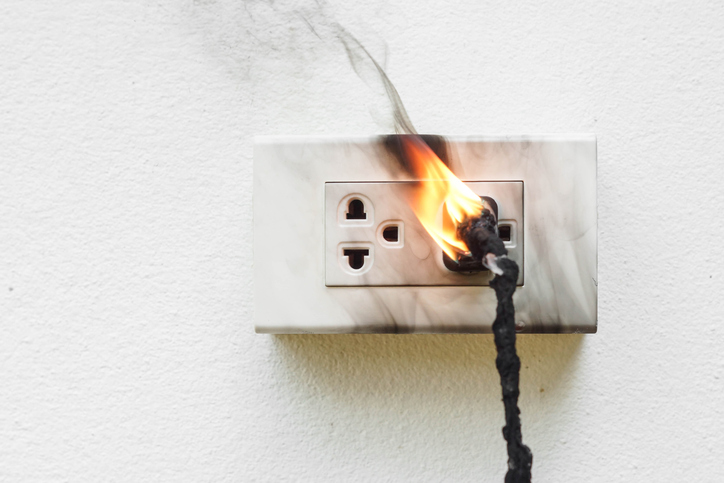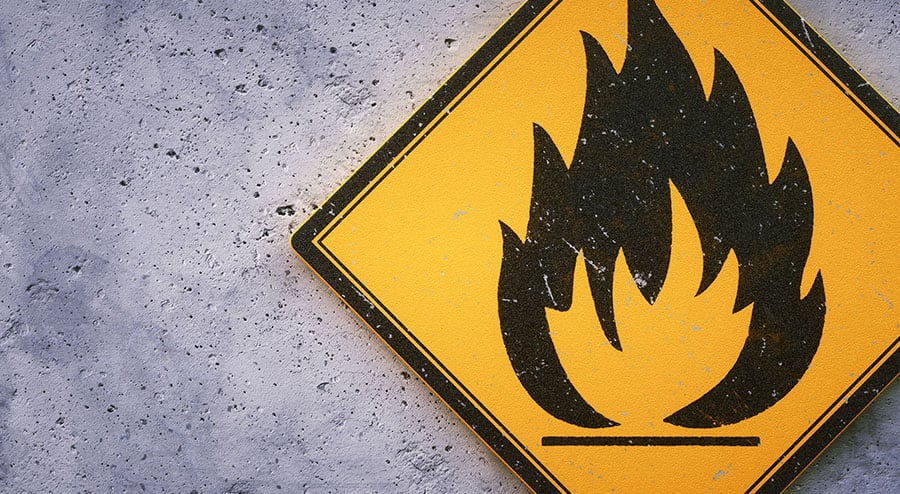Electrical safety is important in every home as electrical fires can pose serious threats to both property and lives. From faulty wiring to overloaded circuits and substandard electrical products, the risks are diverse and require vigilant attention.

By understanding the common causes of electrical fires and recognizing warning signs, homeowners can take proactive measures to protect their households. Regular electrical system inspections by qualified professionals play an important role in identifying potential hazards and ensuring the overall safety of the electrical setup. Additionally, implementing fire prevention measures, such as avoiding overloads and practicing proper appliance safety, can significantly reduce the risk of electrical fires. From educating family members about electrical safety to safeguarding against lightning strikes and power surges, homeowners should be aware of essential maintenance and safety tips in order to prevent home electrical fires effectively.
Table of Contents
Common Causes of Home Electrical Fires
Common causes of electrical fires include faulty wiring, which occurs when wiring becomes damaged or deteriorates over time. Frayed or exposed wires can create sparks and overheat, leading to fires. Regular inspections by licensed electricians can help identify and address such issues promptly and prevent potential hazards.
Overloaded circuits are another significant concern. When homeowners plug multiple high-power devices into a single outlet or power strip, it can exceed the circuit’s capacity, causing overheating and potential fires. Utilizing surge protectors with built-in circuit breakers can mitigate this risk by automatically shutting off power when the circuit is overloaded.
The use of counterfeit or substandard electrical products can be particularly dangerous as these products often lack the necessary safety certifications and features found in reputable brands. Investing in quality electrical products from well-known manufacturers may be slightly more expensive, but the peace of mind and enhanced safety they offer are well worth the cost.
You can ensure a safe living environment and reduce the risk of incidents by understanding these leading causes of electrical fires and taking necessary precautions.
Regular Electrical System Inspections
Professional electrical inspections should be scheduled at regular intervals to ensure that their electrical setup remains in optimal condition. An annual inspection is generally recommended, but it might be more frequent if the house is older or has experienced electrical issues in the past.
Qualified electricians can identify potential hazards during these inspections, such as frayed wires, loose connections, or outdated components. Timely detection and rectification of such issues can prevent them from escalating into serious fire risks. Additionally, an inspection may reveal the need for electrical upgrades to comply with current safety standards and regulations.
Recognize warning signs that indicate the need for electrical maintenance such as flickering lights, frequently tripping circuit breakers, or outlets that feel warm to the touch as these are clear indications that something might be amiss with the electrical system. In such cases, immediate action should be taken to address the underlying issues, either by contacting a professional electrician or the utility company, if necessary.
Electrical Appliance Safety
Proper use and maintenance of electrical appliances includes regularly inspecting appliances for signs of wear, tear, or damage. For instance, frayed cords, loose plugs, or malfunctioning switches should be addressed promptly. It is also crucial to follow the manufacturer’s instructions regarding maintenance and cleaning to ensure the appliances function optimally and safely.
Extension cords should only be utilized as temporary solutions. Prolonged use of extension cords can lead to overheating and fire risks. Instead, consider installing additional outlets strategically to minimize reliance on extension cords. Furthermore, investing in high-quality surge protectors can protect sensitive electronic devices from sudden voltage spikes caused by lightning or power surges. A reputable brand like APC offers surge protectors with varying capacities, typically ranging from $15 to $50, depending on the number of outlets and protection features.
Childproof electrical outlets and protect young children from electrical hazards by utilizing outlet covers or safety plugs can be easily obtained from various brands such as Safety 1st or Dreambaby, with prices ranging from $5 to $15 for a pack of 12 or more. These simple safety measures can significantly reduce the risk of electrical accidents and provide peace of mind for parents.
By adhering to these electrical appliance safety tips, homeowners can ensure the proper functioning and longevity of their devices while mitigating fire hazards in their living spaces.
Fire Prevention and Safety Measures
When it comes to electrical outlets and switches, it is essential to avoid overloading them with multiple high-power devices to minimize the fire and hazard risk. Utilizing power strips or extension cords equipped with surge protectors and circuit breakers can help distribute the electrical load more effectively and prevent overheating. A reputable surge protector like the Belkin 12-Outlet Pivot Plug Power Strip Surge Protector, priced at around $40, offers added protection and convenience with its rotating outlets.
Prevent accidents by handling electrical repairs and installations with caution. While it may be tempting to undertake DIY electrical work, it is advisable to leave such tasks to licensed electricians. Improper repairs or installations can lead to serious hazards, including electrical fires. If homeowners notice issues with their electrical systems, like flickering lights or sparks, contacting a professional electrician is the safest course of action. The cost of hiring an electrician varies depending on the location and the complexity of the job but generally ranges from $50 to $100 per hour.
Moreover, when using space heaters and electric blankets, follow safety guidelines diligently. Space heaters should be kept at least three feet away from flammable objects, and electric blankets should not be left unattended while in use. Opting for newer models with advanced safety features, like auto-shutoff mechanisms, can add an extra layer of protection. Brands like Dyson, Lasko, or Honeywell offer space heaters ranging from $50 to $300, depending on the size and features, while electric blankets can cost anywhere from $30 to $150.
Adhering to these fire prevention and safety measures allows for homeowners to create a secure living environment, significantly reducing the risk of electrical fires.
Educating Family Members
When educating family members about electrical safety, start by discussing the potential risks associated with electrical appliances, outlets, and switches. Teach family members to recognize warning signs of electrical issues, such as flickering lights or unusual odors. Encourage them to report any concerns immediately to the responsible adults in the household.
Involving children in fire escape planning can instill a sense of responsibility and preparedness. Develop a clear and practical fire escape plan, identifying escape routes from each room and a designated meeting point outside the home. Conduct regular fire drills to practice the escape plan with all family members, especially children. Consider using interactive tools like the Kidde 468093 KL-2S Two-Story Fire Escape Ladder, available for around $40, to ensure that all family members can safely exit the upper floors during an emergency.
Consistently reinforce good safety practices to promote a safety-conscious mindset among family members. Encourage them to turn off electrical appliances when not in use and unplug chargers to prevent energy wastage and reduce fire risks. A visible reminder, like the Eco-Baby Child Safety Electrical Outlet Covers, priced at around $15 for a pack of 38, can be installed to remind everyone to keep unused outlets protected.
By following these approaches to educate family members about electrical safety, involving children in fire escape planning, and cultivating a safety-conscious mindset, homeowners can create a safety culture within the household, enhancing overall preparedness and reducing the likelihood of home electrical fires.
Lightning Strikes and Power Surges
Be sure to protect your home from lightning-induced electrical fires in areas prone to thunderstorms. Lightning strikes can cause power surges that may damage electrical devices and even spark fires. To safeguard against such risks, homeowners can install lightning rods on their roofs. A reputable option is the ERITECH 10018-009 Copper Lightning Rod, priced at approximately $60, which effectively dissipates lightning strikes’ energy and directs it safely into the ground, minimizing damage to electrical systems.
The installation of surge protectors and circuit breakers can shield electronic devices from power surges. A surge protector like the APC P11VT3 11-Outlet Surge Protector, priced at around $25, can prevent voltage spikes from reaching sensitive electronics like computers, televisions, and gaming consoles. Circuit breakers act as automatic switches that interrupt the flow of electricity when overloaded, preventing overheating and electrical fires. Hiring a licensed electrician to install these protective devices ensures proper wiring and optimal protection for the entire household.
Significantly reduce the risk of electrical fires caused by natural events and maintain the integrity of their electrical systems by following these guidelines.
DIY Electrical Work
Improper DIY electrical repairs or installations can lead to serious hazards, including electrical fires, electric shocks, and damage to electrical systems. It is important for homeowners to recognize their limitations and prioritize safety over cost-saving measures.
Electrical projects that involve extensive wiring, circuit modifications, or panel upgrades should always be left to licensed electricians. These professionals possess the expertise and experience to handle electrical tasks safely and efficiently. Simple tasks like replacing a light fixture or a wall outlet cover may be suitable for DIY, but even then, it is essential to follow safety guidelines and switch off the circuit breaker before starting any work.
Homeowners should know when to seek professional help for electrical repairs and installations. If they encounter electrical issues like frequent circuit breaker trips, sparking outlets, or persistent electrical malfunctions, contacting a licensed electrician is the best course of action. The cost of hiring an electrician varies depending on the location and the complexity of the job but generally ranges from $50 to $100 per hour. Investing in professional electrical services can prevent accidents, ensure code compliance, and provide long-term peace of mind.
Prioritize safety and protect your households from potential electrical hazards by understanding the risks associated with improper DIY electrical work and knowing when to seek professional help.
Kitchen Safety
The kitchen is a high-risk area for electrical fires due to the frequent use of various electrical appliances. Reduce the risk of such incidents by taking proactive measures and practicing kitchen safety guidelines such as ensuring proper usage and maintenance of kitchen appliances in order to prevent potential fire hazards.
Follow the manufacturer’s guidelines and safety instructions when using kitchen appliances. Avoid overloading electrical outlets with multiple appliances by using power strips with surge protectors. Unplug small appliances like toasters, coffee makers, and blenders when not in use to prevent energy wastage and potential electrical malfunctions.
Regularly inspecting kitchen appliances for signs of wear and damage is vital. Check for frayed cords, loose plugs, or malfunctioning switches, and promptly address any issues. Routine cleaning of appliances, such as removing grease and food debris, can prevent the buildup of flammable materials.
Investing in modern kitchen appliances with advanced safety features is another effective strategy. Brands like KitchenAid, Bosch, and GE offer a wide range of kitchen appliances equipped with automatic shutoff mechanisms and overload protection. While the initial cost may be higher, these safety features offer added protection and peace of mind in the long run.
Identifying Faulty Wiring
Homeowners should be attentive for signs of potential wiring problems, such as flickering lights, frequent circuit breaker trips, or outlets that feel warm to the touch. If any of these warning signs are noticed, it’s essential to act promptly and seek the expertise of a licensed electrician.
Professional electricians can conduct thorough inspections to pinpoint the exact location and cause of faulty wiring. They may use advanced tools like circuit testers or infrared cameras to detect hidden issues within the electrical system. Timely repairs or replacements of damaged or deteriorating wiring can prevent sparks, arcing, and potential electrical fires.
The electrical panel, also known as the circuit breaker panel, plays a crucial role in fire prevention. It acts as a safety mechanism, monitoring the flow of electricity and shutting off circuits when overloaded. Regularly checking and maintaining the electrical panel is essential to ensure it functions correctly. Upgrading to modern electrical panels, such as the Siemens 200 Amp 30-Space 42-Circuit Indoor Main Breaker Load Center, priced at approximately $150, can enhance safety and accommodate increased electrical demands in modern households.
Being proactive in identifying and addressing faulty wiring issues and ensuring the proper functioning of the electrical panel allows homeowners to significantly reduce the risk of electrical fires and maintain a safer living environment.
Responding to Electrical Fires
In the event of an electrical fire, know how to respond promptly and effectively in order to minimize damage and ensure safety by prioritizing personal safety. If the fire is small and manageable, homeowners can attempt to extinguish it using a fire extinguisher appropriate for electrical fires. The First Alert HOME1 Rechargeable Home Fire Extinguisher, priced at around $25, is specifically designed for electrical fires and offers a reliable and compact solution.
However, if the fire is spreading rapidly or poses any risk to personal safety, evacuate all occupants from the premises immediately. Designate a safe meeting point outside the home to ensure that everyone is accounted for. Under no circumstances should anyone re-enter the building until it has been deemed safe to do so by the fire department.
Once outside, promptly call emergency services to report the fire and provide detailed information about the location and nature of the incident. Do not attempt to handle the fire on your own; leave it to the trained professionals. While waiting for help to arrive, avoid touching or tampering with electrical devices or outlets, as there may be live wires and the risk of electric shock.
Take Away
Prioritizing electrical safety at home through regular inspections, educating family members, and seeking professional help for electrical repairs can significantly reduce the risk of fires. Additionally, protecting homes from lightning-induced electrical fires with lightning rods and surge protectors adds an extra layer of safety. By implementing these measures and fostering a safety-conscious mindset, homeowners can create a secure living environment, minimizing fire risks and promoting a sense of security within their households.




